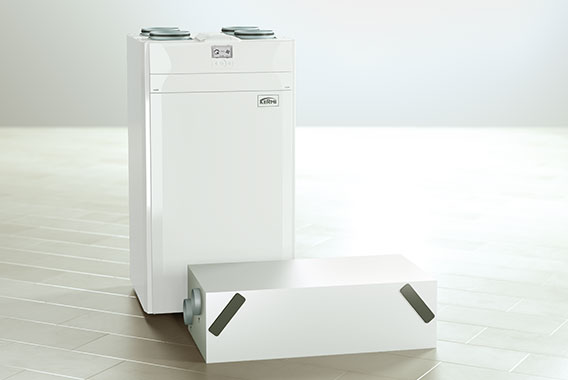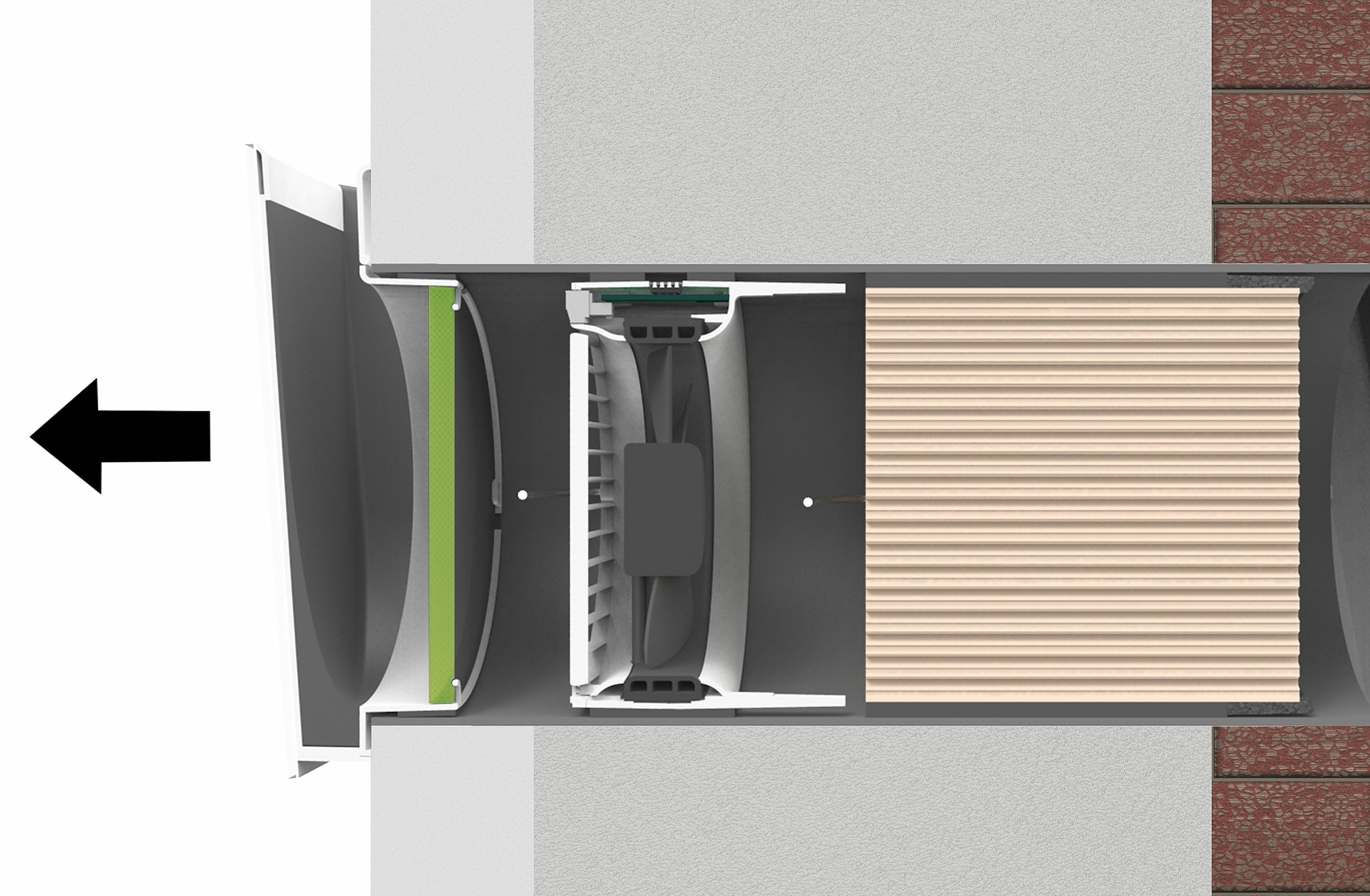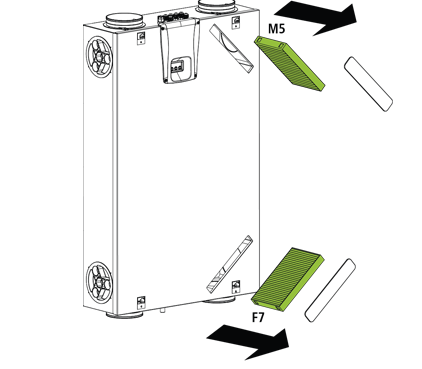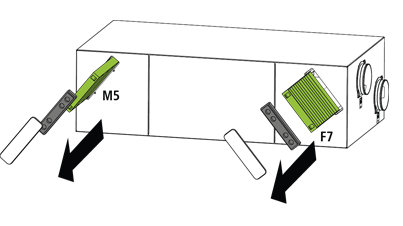The importance of controlled residential ventilation
Controlled residential ventilation continuously supplies living spaces with fresh air. The filters it contains – comprising both outside air filters and extract air filters – play an important role in this.
The outside air filter ensures that the supply air coming into the house is clean and fresh. This means that fine dust and pollen, as well as spores, viruses, and bacteria from the outside, cannot get into the building.
In addition to that, outside air filters protect installed components against soiling.
The used air is returned to the outside via the extract air filter. Dust and dirt particles are also filtered out of the extract air to prevent soiling of the unit.
This ensures the heat exchanger operates cleanly and maintains efficiency in the heat recovery process (there is also the option of inserting filters directly into the extraction openings, which are also intended to protect the pipe system from getting dirty).

Filter quality according to DIN EN ISO 16890
ISO 16890 came into force in December 2016, providing concrete specifications for filter evaluation and filter classification. It has now been valid since mid-2018. The standard describes the air filters for general ventilation and air conditioning technology, and divides the filters into four filter class groups. They are now also adapted to the fine dust classes applied by the WHO (World Health Organisation). ISO 16890 replaces known filter classes such as G4 or F7.
Many studies deal with the effects of particulate matter on human health. The results clearly show that air pollution is highly harmful to health. A WHO study confirms that inhalation can lead to lung or cardiovascular disease with early death. The study’s findings not only prove that coarse dust (PM 10), which has already been recognised as problematic for health, is responsible for health problems and shortened life expectancy, but also show that fine dust is even worse.
Particle sizes and filter classifications

external filters
compliant with ISO 16890 in all central ventilation units.
ISO Coarse (particles > 10 μm)
Sand, fluff, flying seeds, fine hairs
These can get into your nose and mouth.
ISO ePM 10 (particles <= 10 μm)
Pollen, rock dust, dust from field cultivation
These can get into the upper respiratory tract.
ISO ePM 2.5 (particles <= 2.5 μm)
Bacteria, fungal and mould spores, pollen, toner dust
These can get into the lower respiratory tract.
ISO ePM 1 (particles <= 1 μm)
Viruses, bacteria, nanoparticles, soot from fossil fuels, sea salt, oil mist
These can get into alveoli and the bloodstream.
(Explanation: e.g. ISO ePM 2.5 60 % (particles ≤ 2.5 μm): ePM 2.5 denotes the particle size for particles ≤ 2.5 μm. 60 % denotes that particles with a size of up to 2.5 μm are filtered at a rate of 60 %.)
How often do the filters in ventilation systems need to be replaced?
The filters need to be replaced at regular intervals. This ensures that:
- hygienic requirements for the ventilation system are permanently guaranteed
- safe and economic operation is maintained
- the ventilation system has a long service life
For normal filters, replacement every 60 to 180 days is common. The extract air filter is often more polluted than the outside air filter, because living indoors produces house dust that is then ends up in the extract air filter.
Maintenance by the user is limited to regular filter changes.
If the symbol for changing the filters appears on the display, they should be replaced with new original filters. The unit must not be used without filters.
Note on maintenance by a specialist:
Every two years, your x-well residential ventilation system should be serviced by a specialist who will thoroughly check it.

Filter changes couldn’t be simpler
No tools are required to change the filters on any of the units!
The filters need to be changed at the latest when the symbol is shown on the display.
Changes can be carried out in just a few steps and are extremely easy.
x-well S-series central residential ventilation
The filters (marked green) are located behind the filter flap and the EPDM closures.
1. Switch off the unit. Only ever change the filters while the unit is de-energised.
2. Open the filter flap and remove the dark foam (EPDM closures).
3. Remove the outside air filter F7 and the extract air filter F5. Pay attention to the direction of the arrows. The arrows on the filter and on the filter shaft show the flow direction.
4. Insert the new original filters in the direction of the arrows (air flow direction).
5. Working in reverse order, insert the EPDM closures again and close the filter flap.
6. Switch the unit on again and acknowledge filter maintenance on the display.

x-well D-series decentralised ventilation
Check the dust filter every six months and the pollen filter every three months (green markings). In this case too, it takes just a few steps to change the filters. The filters are located behind the inner panel.
1. Disconnect the fan from the power supply. Only ever change the filters while the unit is de-energised.
2. Pull the inner panel of the fan out of the installation pipe.
3. How to clean dust or pollen filters
| Component | Interval | Measure |
| Dust filter | Every six months | Use a vacuum cleaner to clean the dust filter Wash the dust filter with warm water Replace the dust filter if it is heavily soiled/defective |
| Pollen filter | Every three months | Use a vacuum cleaner to clean the pollen filter Replace the pollen filter if it is heavily soiled/defective |
A detailed description of user maintenance can be found in the installation and operating instructions

Where can I get KERMI original filters from?

You can easily order all original filters for your KERMI controlled residential ventilation system from our online spare parts shop.
Benefits of original filters from KERMI
- High supply air quality through targeted and effective filtering of fine dust, pollen, bacteria, viruses, etc.
- High level of filter safety even for the smallest particles thanks to the exclusive use of outside air filters with class ePM 1 according to ISO 16860 for central units.
- Low operating costs and low energy consumption due to consistently good heat transfer and low pressure loss despite the high filter class (ePM 1 55 %).
- High filter efficiency and continuously good filtration for clean air.
- Fully recyclable due to the use of filter material made of polyester; no hazardous materials such as glass fibre.
- Compact and stable design.

